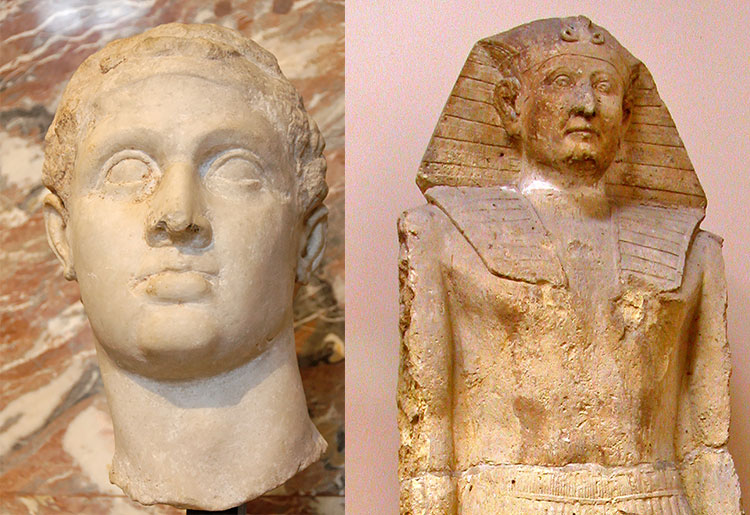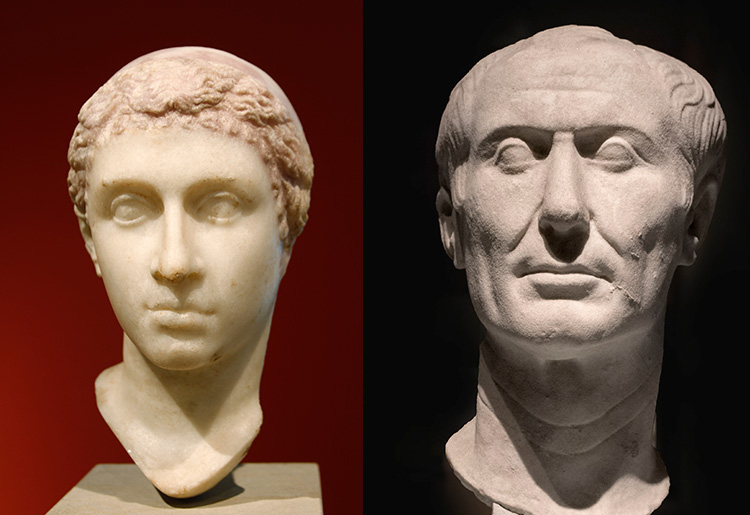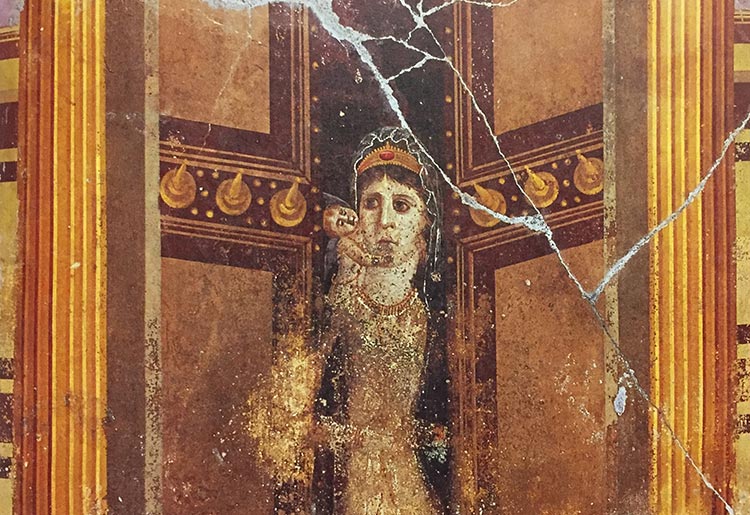This educational video is a visual version of this article and presented by Artificial Intelligence (AI). Please see our AI ethics and diversity policy for more information on how we use AI and select presenters on our website.
Cleopatra the VII’s famous relationship with Julius Caesar has its beginnings in the Egyptian ruler’s ascent to power at the hands of the Roman dictator. It was at first a political alliance.
Ptolomy’s power play
Cleopatra’s father Ptolemy XII Auletes had decided to ally with Rome, as he rightly believed it was becoming the region’s greatest power. But there were powerful Egyptians and Greeks who disagreed with this policy and decided it would be better to have Cleopatra in control.

Marble statue of Ptolemy XII, 1st century BC (left); Egyptian-style statue of Ptolemy XII found at the Temple of the Crocodile in Fayoum, Egypt (right). Image credit: Public domain, via Wikimedia Commons
So Ptolemy paid Rome to invade Egypt and guarantee his place in power, incurring large debts by borrowing from a Roman businessman in the process. As was the custom of the Greek Ptolemy dynasty in Egypt, Cleopatra and her brother Ptolemy XIII were married in order to maintain the family’s power and inherited the rule of Egypt upon the death of their father in 51 BC.
A pair of civil wars
During Caesar’s civil war with Pompey, the latter fled to Egypt. Caesar pursued Pompey — who had already been murdered by a trio of treasonous Roman military men who were stationed there — and defeated his armies at Alexandria.
Meanwhile, in the midst of a civil war between her supporters and those of her brother, Cleopatra sought help from Caesar. In order to avoid being caught by her brother’s forces, she was secreted into Alexandria while rolled up in a carpet. Her servant, disguised as a merchant, unrolled the Queen in front of Caesar inside the general’s suite.
A mutually beneficial relationship
The pair’s need of one another was mutual. Cleopatra required the might of Caesar’s armies to install her as ruler of Egypt, while Caesar was in need of Cleopatra’s vast wealth. She is believed to have been the world’s richest woman at the time and able to finance Caesar’s return to power in Rome.

Bust of Cleopatra VII (left); Bust of Julius Caesar (right). Image credit: Public domain, via Wikimedia Commons
Caesar declared Cleopatra and Ptolemy XIII to be joint rulers, but this was not accepted by Ptolemy’s supporters, who laid siege to the palace in Alexandria. Meanwhile Cleopatra’s younger sister, Arsinoe, escaped and declared her own rebellion. Caesar and Cleopatra were stuck inside for several months before Roman reinforcements arrived, allowing Caesar to take all of Alexandria.
Placing Ptolemy XII’s daughter on the throne meant she would inherit her father’s debts to Rome and was capable of paying them off.
With Cleopatra successfully installed, the couple cruised the Nile on the Queen’s royal barge, after which Caesar returned to Rome, leaving a Cleopatra with child.
Cleopatra in Rome
The Queen, who was unpopular in Alexandria, required the protection of Roman legions. After a year she came to Rome where Caesar housed her on one of his estates.
In Rome Caesar had a gilded statue of Cleopatra erected, but it is not known if their affair continued. Although marriage between a Roman and a foreigner was not permitted (not to mention the fact that Caesar was already married), he never denied fathering her child.

A Roman painting in the House of Marcus Fabius Rufus at Pompeii, Italy, depicting Cleopatra as Venus Genetrix and her son Caesarion as a cupid. Image credit: Public domain, via Wikimedia Commons
The Goddess-Queen of Egypt did not fit into Roman morals and upon Caesar’s assassination, Cleopatra returned to Egypt where she later had another legendary affair and illegal marriage with Marc Antony.
Caesar’s son
During the time in which Caesar stayed with Cleopatra in Egypt, he is believed to have fathered her son, Ptolemy XV Caesarion, born on 24 June 47 BC. If Caesarion was indeed Caesar’s son as his name suggests, he was Caesar’s only biological male issue.
Caesarion, the last king of Egypt’s Ptolemy dynasty, ruled together with his mother until Octavian (later Augustus) had him killed on 23 August 30 BC. He was Egypt’s sole ruler for the 11 days between Cleopatra’s death and his own.
















